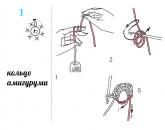Gold thread for embroidery 8 letters. Gold and silver threads. Alternative questions in crossword puzzles for the word gimmick
To thread the needle, pinch the neatly cut end of the thread between your thumb and forefinger so that the tip of the thread is just slightly peeking out. Bring the needle to the thread and slightly turn the pads of your fingers. Typically, this will cause the thread to automatically slide into the eyelet.
Now you know what are the features of working with threads in gold embroidery.
Metallized threads
Metallic threads can be divided into 2 categories: hollow thread and embroidery thread - with some exceptions. Thread is available in a variety of qualities and metals, including threads containing up to 2% gold, gold plated, 90% silver, silver braid, copper. Many threads come in different sizes (thicknesses).
Thread map
Gimp
There are 4 types of hollow gimp: shiny faceted, twisted faceted, smooth and matte. They only differ appearance, but are used in the same way: cut into pieces and strung on a thread like beads. Typically, waxed polyester or silk thread is used, sometimes metallized to hide the stitches.
Embroidery threads
What are the features of working with threads in gold embroidery? Embroidery threads are made from core threads wrapped in thin strips of metal. They are very fragile at the ends and unwind easily, so you need to leave allowances at the beginning and end, then pull these threads to the wrong side and secure them there.
Japanese gold threads: round in cross-section, high quality, very bright and smooth;
Imitation Japanese gold: round in cross-section, delicate shades;
Gold-plated: round in cross-section, very flexible, thin threads, smooth or twisted;
Corrugated and 8x2 corrugated: round in cross-section, zigzag in shape;
Rococo: round in cross-section, soft, wavy;
Flat: round in cross-section, slightly flattened;
Elizabethan yarn: very fine, double;
Twisted threads consist of several threads twisted together. They need to be treated the same as regular ones. There are several varieties of twisted threads.
Thread is sold in skeins or spools
Embroidery threads
These threads can be threaded directly into a needle and embroidered with them. It's best to cut the threads short length because they are very soft.
Reinforced thread: very thin metal thread. It comes in gold and silver.
Threads: triple metallized thread. It comes in gold and silver.
Cords: thin metallic threads of different colors.
Others
Wide braid: strips of flattened metal that resemble a ribbon in appearance.
Twisted braid: A wide strip of flattened metal wrapped in thin metal wire.
Corrugated braid: wide braid with a corrugated surface.
Milliary: elegant openwork thread.
Sequins: Same as glitter.
Laika: Metallic leather available in different shades.
Colored threads
Available in various color shades. Below is a selection of some of them, including Shiny Faceted Gimp, Twisted Gimp, Smooth Gimp, Matte Gimp, Triple Twist, Milliary and Rococo.
Technicians
Gold embroidery can look different depending on different combinations of materials and techniques, as shown in the following examples.


Gold or silver embroidery thread
The first letter is "k"
Second letter "a"
Third letter "n"
The last letter of the letter is "b"
Answer for the question "Gold or silver embroidery thread", 8 letters:
gimmick
Alternative questions in crossword puzzles for the word gimmick
Stretchy thread
Difficulty and red tape
An annoying waste of time; story by A. Chekhov
Long-drawn-out resolution of the case
Chekhov's story
Story by A. Chekhov
Definition of the word gimmick in dictionaries
Encyclopedic Dictionary, 1998
The meaning of the word in the dictionary Encyclopedic Dictionary, 1998
GIMPLE (from the French cannetille) is a very thin metal (usually gold or silver) thread for embroidery. In a figurative sense, it is a tedious, protracted matter.
Explanatory dictionary of the Russian language. D.N. Ushakov
The meaning of the word in the dictionary Explanatory Dictionary of the Russian Language. D.N. Ushakov
gimps, plural no, w. (French cannetile). Thin twisted gold or silver wire, used. for embroidery. Pull the gimp. (make it). A skein of gimp. trans. An annoying waste of time; sth. very boring, monotonous (colloquially). I'm tired of this...
Explanatory dictionary of the Russian language. S.I.Ozhegov, N.Yu.Shvedova.
The meaning of the word in the dictionary Explanatory Dictionary of the Russian Language. S.I.Ozhegov, N.Yu.Shvedova.
-i, f. Very fine metallic embroidery thread. Pull to (make it). Golden k. transfer. A tedious, protracted business (colloquial). K. pull, spread. Enough of the rigmarole! adj. duct, -aya, -oe (to 1 value). Canal production.
Examples of the use of the word gimmick in literature.
The pine needles fell from it like rain, the threads glittered on the branches like an autumn cobweb rigmarole, Berthollet salt crunched underfoot, representing snow.
I lightly patted Jock on the shoulder and said: “Hold on, Jock, now you’ll grab a liter of mash, and everything will be fine, we’ll get you this gimmick.
Now he saw her face: dark semicircles of eyebrows, a clean high forehead, a plump, slightly open mouth with glittering pearls of teeth, small ears with gold earrings. rigmarole.
After all this - no gimmick Isn’t life a ringleader, isn’t it bagpipes?
To the land where the agricultural cartel, united in a cartel, grows the cartel and pulls, pulls gimmick.
Gold embroidery- embroidery with gold and silver thread is a very ancient type of needlework. The very first information about gold embroidery dates back to the 2nd century BC. e., when Attalus ruled in the kingdom of Pergamon (northwest Asia Minor). According to legend, it was from there that Attala embroidery came to the Romans - that’s what embroidery with gold thread was called then.
They made metal thread in a special way - dragging, received the thinnest wire, which was called drawn gold(or silver). Wrapping this wire by hand linen thread, received a spun thread, which was called spun. Later they began to make spun thread from drawn gold, silver and gilded silver with silk. This thread is called scan. The fourth type of metal thread was beat(so named after the method of production), which was a very thin and narrow strip. From beating, by twisting this thin strip into a spiral, vitushka, also called gimp. Of course, due to the high cost of the material and the laboriousness of making different threads from it, the price of the threads themselves was very high.

In Rus', references to gold embroidery art are found in chronicles, ancient documents, as well as in reviews of foreign travelers, starting from the 11th century, but especially many descriptions and even products have been preserved from the 15th century. Products dating back to this time represent various church accessories (covers and veils, shrouds, shrouds, curtains, etc.), as well as icons, embroidered iconostases, banners, and banners. Embroidery was done on expensive dense fabrics: taffeta, satin, brocade, velvet, as well as suede and leather. Metal thread is not only expensive, but also very fragile - fragile, it cannot be sewn with it like a simple linen or silk thread. It was laid according to the pattern on the fabric and attached with a silk thread in the color of metal or very bright contrasting colors, creating single-color and multi-color patterns.

Gold embroidery work was carried out in those distant times in monasteries. In the 15th century, gold embroidery began to be used to decorate the clothes of rich people. The names of workshop owners are often found on embroidered items, which indicate that the courts of princes, boyars, and wealthy merchants already had their own workshops - "svetlitsy", where specially selected and well-trained embroiderers worked. The leading position from the end of the 15th century was occupied by the Moscow grand ducal “svetlitsy”, which at the end of the 16th century received the name "Tsarina's bright chambers".
At the same time, and according to some reports, even earlier than gold embroidery, appeared in Rus' pearl sewing. Indeed, in many Russian rivers there was an abundance of freshwater pearls. Masters of gold and pearl embroidery used in their works and gems, and beads, and glass beads, as well as colored garus made of natural silk. They embroidered headdresses, kokoshniks, mantles, collars and cuffs, soul warmers, various bags, bags and handbags, purses, cases for weapons and arrows, scabbards, etc. All of them were very expensive, passed on by inheritance, and constituted the most valuable part of the dowry .

Gradually, small workshops became larger, and gold embroidery artels. One of these centers was the still existing workshop in Torzhok.
Starting from the 17th century, various substitutes for natural expensive metals began to be increasingly introduced into gold embroidery work. Thus, gold and silver threads were replaced by gilded and silver-plated copper and bronze threads, expensive stones and natural pearls were replaced by artificial and glass beads and buttons, instead of natural silk they began to use artificial, and later synthetic. In the 20th century, metal began to be widely replaced with artificial film. This is how it appeared Lurex, and then threads with the addition of synthetic shiny fiber, which gives a metallic shine to silk and cotton threads. An abundance of new materials called gold, imitating metal and metallized threads, allowed a larger number of special workshops and individual embroiderers to engage in gold embroidery. However, new materials remain fragile and fragile, which requires skill in working with them and knowledge of special sewing techniques. In the next issue of the magazine we will introduce you to the rules, seams and techniques of gold embroidery.
Gold and silver were widely used in different types: forged, drawn, cloaked, spun...
The threads could be round (drawn) or flat (flattened, beaten). Gold and silver threads are not strong, they cannot be pulled through the fabric, they break almost immediately. Therefore, metal threads were sewn with very small stitches along front side embroidery or twisted with silk so as not to tear.
They also used a thread called "gimp" - This is a thread in the form of a helical spiral. This thread is more beautiful than a simple one, due to its spectacular color shifts. See photo.
In the encyclopedic dictionary of Brockhaus and Efron we read: “The gimp used in large quantities was of the most varied... gimp production was established in the palace at the beginning of the 17th century, German craftsmen were called in and a gimp factory was established.”
And in the same dictionary you can read about how gimp is made.
“The wire is taken very thin, about 0.1 mm, round or flattened, the so-called “beat”; the first is usually wound on a round rod, the second on a triangular one; when it is removed, the elasticity causes it to unwind a little, as a result of which the correct distribution of bevels is obtained , producing spectacular shimmers of light. For winding the gimp, there are continuously operating machines: a short rod protrudes from a tightly fitting tube and rotates quickly, like the spindle of a lathe. The outer edge of this tube is cut along the helical line of the stroke that the gimp being made should represent. the wire is wound by hand around the entire protruding part of the rod, pressed down with a special roller and the machine is put into operation. The friction between the rod and the wire is enough to wind it further, and the screw edge of the stationary tube constantly pushes the finished spiral and makes room for a new wire. usually cut into short pieces and sewn on with silk passed along the axis of the spiral."
Embroidering with gimp is a very difficult task. This is where the expression “gimp business” was born, i.e. painstaking, tedious.
Currently, gimp is used as before, for decorative finishing.
Until the 18th century, metal lace was very common in Russia. The Encyclopedic Dictionary of Brockhaus and Efron says this: “Nowhere do we find such a wealth and variety of material for lace as we have in Russia. It included drawn gold, German silver, and partly Turkish, scanned and spun with silk , gold and silver beat or gimp, truntsal or struntsal, cartul or cartul and various kinds of so-called sparkles, stars, pepel, squares and ginochki, etc. There was also lace... with tinsel and curly things..."
Gold and silver were not only used to embroider and weave lace, but also to weave fabrics. "... some with gold and silver patterns on the colored background of the fabric, others were woven with gold and silver, so that silver patterns and figures were displayed on the gold field, and gold patterns and figures on the silver field, such as scales, large and small circles, jets, rivers, grass..." *
Such fabrics with gold and silver threads are called brocade. The production of brocade was known at the beginning of the century. e. in China, from where this art spread to the countries of Asia Minor (Syria, Persia, etc.), and then to the south of Europe. The Persian word "brocade" translates as "piece, fabric." It was in pieces that brocade was brought to Russia from Persia. Hat tops, caftans, sheepskin coats, fur coats, and trousers were made from brocade. The first attempts to produce brocade in Russia were made at the end of the 16th century.
Metal threads were widely used to make bassonry products intended for decoration. These are: braid, braid, braid, tassels, fringe, laces, etc. Basketry was very widely used in the military uniforms of the tsarist army.
Only in ancient times were gold and silver threads made from pure precious metal; later, like other jewelry, they began to be made from alloys containing precious metals.
And then they started producing tinsel threads, that is, gold-plated and silver-plated copper threads. This is how the meaning of the word is explained"tinsel" in the encyclopedic dictionary of Brockhaus and Efron. " Tinsel
- the name of gimp, brocade and bassonry products, not real, but made of silver and gilded copper. In a figurative sense it means deceptive gloss and brilliance."
Currently, metal threads are made from alloys of copper, brass, nickel and are thin metal wire anodized with gold or silver. They are produced in very limited quantities and are used mainly for historical costumes, as a finishing and decorative material.
In modern elegant fabrics, flat split threads made of aluminum foil are most often used. (Lurex, alunit) or plasticex.
.Literary sources:
Encyclopedic Dictionary of Brockhaus and Efron.
*N.I.Kostomarov. "Essays on the home life and morals of the Great Russian people in the 16th and 17th centuries"
Vardugin V.I. Russian clothing: History of folk costume from Scythian to Soviet times. - Saratov: Region. Privolzhsky publishing house "Children's book", 2001
Great Soviet Encyclopedia
Popular
- Calculation of old age pension, or counting your pension yourself
- How I brought my husband back to the family
- DIY hairstyles for shoulder-length hair
- Uterine tone during pregnancy: symptoms, increased cervical tone Prevention of uterine hypertonicity
- Fashionable New Year's hairstyles for girls
- How to sew a hair tie (detailed master class) Do-it-yourself elegant hair bands
- Summary of the lesson on artistic creativity “New Year's toy
- Crochet for Beginners
- Work experience of an individual entrepreneur (IP, pboyul) Confirmation of work experience of an individual entrepreneur
- How to determine your color type of appearance test online Take a beauty test for girls




